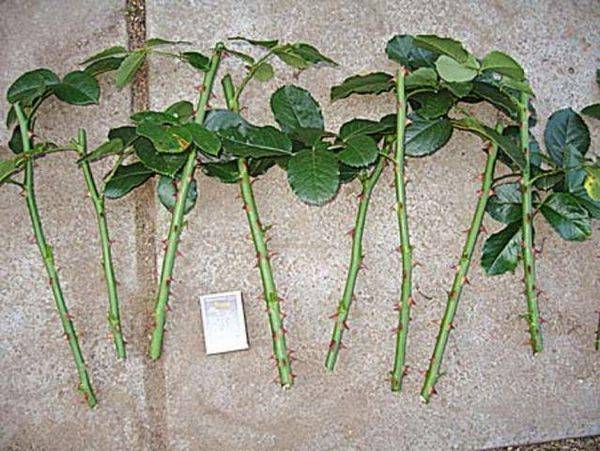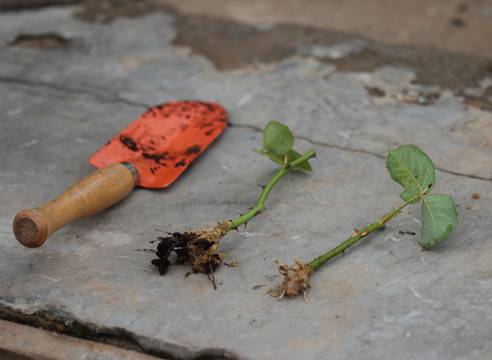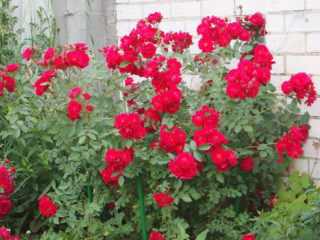Content
For true rose lovers, the question of replenishing the assortment in the garden sometimes arises. Buying ready-made rooted seedlings is expensive, and sometimes the purchased material does not match the attached photo. Most rose growers prefer to grow their favorite varieties themselves. Of all the propagation methods, rose cuttings in the fall are the most accessible and simplest. That is why it is very popular among flower growers. All you need is a pruning shears, the original bush and the desire to turn your garden into a piece of paradise.
What roses can be grown by cuttings?
Before you start taking cuttings, it is important to decide which roses can be grown from cuttings in the fall and which cannot.
It is worth noting that each variety has its own advantages and disadvantages. Therefore, the survival rate of rose cuttings can vary significantly, both up and down.
Cuttings of the following types and varieties take root well:
- Semi-climbing varieties;
- Miniature and polyanthus varieties of roses;
- Varieties Excelsa, Flammentanz, Iceberg, Rosalind.
Hybrid tea varieties also propagate well by cuttings, but their root system is very weak. Therefore, rose experts advise growing them by grafting.
Remontant, climbing and park varieties are more difficult to propagate by cuttings - the rooting percentage is too low, less than 30-40%.
Before propagating a particular variety, it is necessary to collect as much information as possible about the advantages and characteristics of growing this plant.
Compared to other methods of propagating rose bushes, such as grafting or propagation by seeds, cutting roses in the fall is the cheapest and does not require special knowledge and skills.
How and when to take rose cuttings
You can propagate roses from cuttings both in spring and autumn. However, experienced gardeners still prefer autumn cuttings. Why? The main reason is that the cutting process can be combined with autumn pruning rose bushes and work on caring for roses in the garden. Secondly, in autumn the bushes are abundantly covered with flowers, and it is very difficult to confuse which variety you want to propagate. Thirdly, a good housewife never loses anything. After cutting off the excess shoots, you can cut them into cuttings of the required length and plant them. With the arrival of spring, the rooted cuttings will produce their first shoots.
On average, the survival rate of cuttings cut from a bush is approximately 75-80% of the total amount of planted material. At this moment, it is important to give future bushes maximum attention and care, following the recommendations of rose experts. After all, even minor deviations from the rules will nullify all your efforts.
- pruned shoots should be carefully inspected for damage or pests.Only healthy material should be left for cuttings;
- the thickness of the branches should be at least 4-5 mm and no more than the thickness of a pencil;
- each shoot can be divided into several cuttings. Their length should be at least 15-18 cm, and on each cutting there should be at least 3-5 developed and healthy buds;
- from the lower edge of the cutting, the cut should be made at a distance of 1-2 mm from the outer bud, and in the upper part - 5-7 mm. In order not to get confused when planting where the top of the cutting is and where the bottom is, make the bottom cut oblique and the top cut straight;
- The leaf blades of the lower leaves need to be cut off and the petioles left. But it is not recommended to completely cut off the leaves of the upper buds - the process of photosynthesis continues in them almost until the very last warm day. Cut them in half - the remaining leaf blade will be enough for the cutting to develop.
You can plant cuttings prepared for propagation immediately in prepared soil, or you can plant them in boxes or containers for rooting. Wherever you decide to plant the cuttings, before planting, it is advisable to treat their lower part with a solution that stimulates the formation and growth of roots.
Rules for planting rose cuttings in the ground
Before planting roses from cuttings in the fall, you should thoroughly prepare the planting site.
Rose is a very delicate and fastidious flower. And she reacts very sharply to a lack of any elements or nutrients. Many beginning hobbyists complain that even if all the rules for planting roses in the fall are followed by cuttings, only 1-2 shoots out of 10 take root. And the problem can be very simple - the land for planting is not well prepared or the place for future rose bushes is not selected correctly.
To prevent this from happening, let's figure out how to choose a suitable place in the garden and properly prepare the soil.
Choosing a place and preparing the soil for planting roses
Before determining the location of the future rose garden, it is important to know what the queen of the garden loves and what she should be protected from.
Like many flowers, roses are very light- and heat-loving. Therefore, the place should be suitable for it - well lit at any time of the day. But cold and piercing winds are very harmful to her. Therefore, many gardeners choose areas along walls or fences for growing roses.
It is also important to take into account that the groundwater at the site of the future flower garden is not located too close (less than 1 m) to the surface of the earth. Otherwise, there is a danger that the root system will constantly rot, which will immediately affect both the flowering of the bush and its condition.
You should not plant rose cuttings under trees - they will block the sun's rays with their branches. This will immediately affect flowering - there will be few buds on the bushes, the flowers will be faded and small.
The composition of the soil is no less important for roses. Therefore, cuttings need to be planted in loose, fertile soil. If the soil on your site is poor, fertilize and dig up the place for the future flower garden in advance.
Planting rose cuttings
Cuttings are planted in open ground in two ways: immediately in a permanent place or in a “cutting bed” - a specially prepared bed for rooting planting material.
On the one hand, it is preferable to plant rose cuttings in a permanent place - in the future you will not have the hassle of replanting. The distance between the holes in this case will be from 0.6 m to 1.5 m, depending on the type and variety of roses.
On the other hand, plantings must be covered for the winter. In this case, it is easier and simpler to cover the cuttings. With the arrival of spring, when you open the greenhouse, you will immediately see which cuttings have taken root and which ones have not. When planting rose cuttings in the garden bed, you should take into account that the distance between them should be at least 10-12 cm.
Almost immediately after cutting, rose cuttings are ready for planting in the ground. Immediately before planting the material, you need to treat the upper cut of the cutting to prevent the penetration of pathogenic microorganisms. To do this, the cut can be treated with a light pink solution of potassium permanganate or dipped in melted wax.
The holes need to be dug deeper, at least 25-30 cm deep. A layer of mowed grass should be placed at the bottom of the planting hole, filling the hole by about a third or half. Place a layer of rotted manure or compost on top of the grass and water the hole generously. Place the cutting in the middle at a slight angle and sprinkle with soil. The soil must be compacted.
In the autumn, for successful rooting, rose cuttings need high humidity - at least 80-90%. Therefore, after planting, experienced gardeners and rose growers cover the cuttings with glass jars or cut plastic bottles. An ideal microclimate is created under them, conducive to the preservation and germination of seedlings. It is advisable to choose transparent containers. Banks are removed only in the spring.
The planted material must be mulched with dry leaves or peat.
Transplant It will be possible to transfer seedlings to another place only next fall.
It is important to remember that cuttings of roses in the fall must be completed at least two weeks before the expected frost.
Sheltering planted rose cuttings for the winter
After planting the cuttings in open ground, it is important to provide them with good protection - to reliably cover the plantings in anticipation of the coming winter.
The cuttings are covered by constructing a miniature greenhouse over it. Most often, avid flower growers use improvised material. Several arcs of metal rods are installed above the bed and placed at a distance of 50-60 cm from each other. Any waterproofing material is laid on them. Ideal for this purpose: polyethylene film, agrofibre, lutrasil.
Covering material must be secured along the edges of the mini-greenhouse to prevent cold air from entering inside. Boards, bricks or stones are laid on the edges of the material around the perimeter. Cover the top of the greenhouse with additional dry leaves or spruce branches, and at the first snowfall, throw more snow on it. Now your future flowers are not afraid of even the most severe frosts.
If you decide in the fall to plant roses with cuttings immediately in a permanent place, then you should build some kind of tent over each future bush. The remaining steps and material are identical to the method of covering the cuttings described above.
In the spring, you need to open the plantings gradually, layer by layer. First, as soon as the thaw begins, throw away the snow.Then you will need to remove the spruce branches. The greenhouse also needs to be opened gradually. If you have done all the work with diligence, then in a couple of weeks you will see the first green shoots.
As you can see, growing a rose using cuttings is not that difficult. It is important to follow all the recommendations of rose experts.
The author of the video will tell you how to properly cut roses:
Rooting rose cuttings in containers
Not all gardeners plant rose cuttings directly in open ground in the fall. Some people prefer to root them both in containers and in boxes or buckets, and in the spring they plant them in the garden.
Cuttings are planted in containers in cases where the time for planting in the flower garden has already been lost or there is no way to get to the summer cottage, and it is necessary to preserve valuable planting material.
The container for rooting rose cuttings should be deep and spacious. Plastic buckets are ideal for this purpose.
- Place a drainage layer 5-6 cm thick at the bottom of the container. River pebbles or expanded clay are excellent for these purposes.
- Fill a bucket or container with soil. You can mix the soil with the mixture for rooting and growing roses in a 1:1 ratio. For long-term moisture retention and better rooting, professionals advise adding Agroperlite or Vermiculite to the soil in an amount of 15-20% of the total volume.
- Lightly moisten the soil. The most convenient way to do this is with a spray bottle.
- Make small vertical holes with a stick slightly larger in diameter than the thickness of the rose cuttings. The distance between the holes should be at least 8-10 cm.
- Dip the lower cut of the cutting first into water, and then into “Kornevin” and immediately insert it into the prepared holes. "Kornevin" is an excellent stimulator for the formation and active growth of the root system.It is important that the lower cut is completely in the ground, without touching the drainage layer.
- Firm the soil well around the planted cuttings.
The box or bucket with the planted cuttings must be wrapped in transparent plastic film and secured with a rope or stapler, preventing air penetration. You can make a small hole in the top of the film, which should be immediately closed with a regular clothespin. By removing and putting on the clamp, you can easily regulate the air temperature in the greenhouse in the spring.
The container with planted rose cuttings should be taken out onto the loggia, glazed balcony or veranda. It is important to consider that the indoor temperature may differ only slightly from the outdoor temperature.
In severe frosts, the plantings must be covered with an old jacket or blanket or brought indoors for a short period.
You can plant rooted seedlings in open ground in the usual way as soon as the ground warms up. When replanting, it is important to very carefully remove established cuttings from the soil so as not to damage the delicate roots.
How to save cuttings until spring
Sometimes circumstances develop in such a way that it is not possible to plant rose cuttings immediately in the ground for rooting in the fall, and you need to save excellent planting material until spring. There are at least two ways to preserve cuttings.
How to keep cuttings in the basement
Our grandparents used this method of preserving rose cuttings. They wrapped the lower edge of the cut cuttings in 3-4 layers with a piece of burlap soaked in water, wrapped them in a plastic bag and sent them to the cellar until spring.The room temperature should not exceed +2˚С +3˚С, and humidity should not exceed 70-75%.
At least 2-3 times a month you need to check the condition of the material for moisture. If the burlap begins to dry out, moisten it with a spray bottle. In the absence of burlap, you can use any cotton rag. Synthetics cannot be used in this case.
In the spring, carefully remove the rose cuttings from the basement and carefully remove the burlap. If you did everything correctly, you will see small roots at the end of the cuttings. Now the seedlings can be planted in open ground using the usual method.
How to keep cuttings in the garden
There can be many reasons for saving rose cuttings until spring. The place for planting is not ready, the planting material was purchased or cut late, the weather is bad. What to do in such a situation? In any case, you can bury the cuttings in a remote place in the garden, and in the spring plant them according to all the rules.
- Dig a small trench, the width of which should exceed the length of the rose cuttings by 5-7 cm, and the depth of approximately 20-30 cm. Its length depends on the amount of material. Keep in mind that the distance between the branches should be at least 7-9 cm.
- The bottom of the trench must be covered with straw or peat.
- Lay the planting material across. Don't forget to cut off all the leaves from the cuttings before doing this.
- Cover them on top with any covering material: lutrasil or agrofibre.
- Fill the trench with soil and mulch with spruce or pine branches and dry leaves.
- Don’t forget to mark the boundaries of the trench with pegs so that when spring comes you don’t waste time and effort searching for planting material.
As soon as the snow falls, cover the bed with a natural blanket. In the spring, such rose cuttings should be planted in a cutting box or in a permanent place immediately after being removed from the ground. Please take this into account when planning your work on the site and, if possible, prepare the site in advance.
You will learn how to save rose cuttings in the fall and plant them in the spring from the video:
Conclusion
Perhaps propagating roses using cuttings will seem too complicated and troublesome to you. Cuttings are a truly difficult process, requiring experience and skill. And experience, as you know, is a gainable thing. But all your efforts will be more than paid for when the buds begin to bloom in the rose garden, emitting a delicate, divine aroma.




























